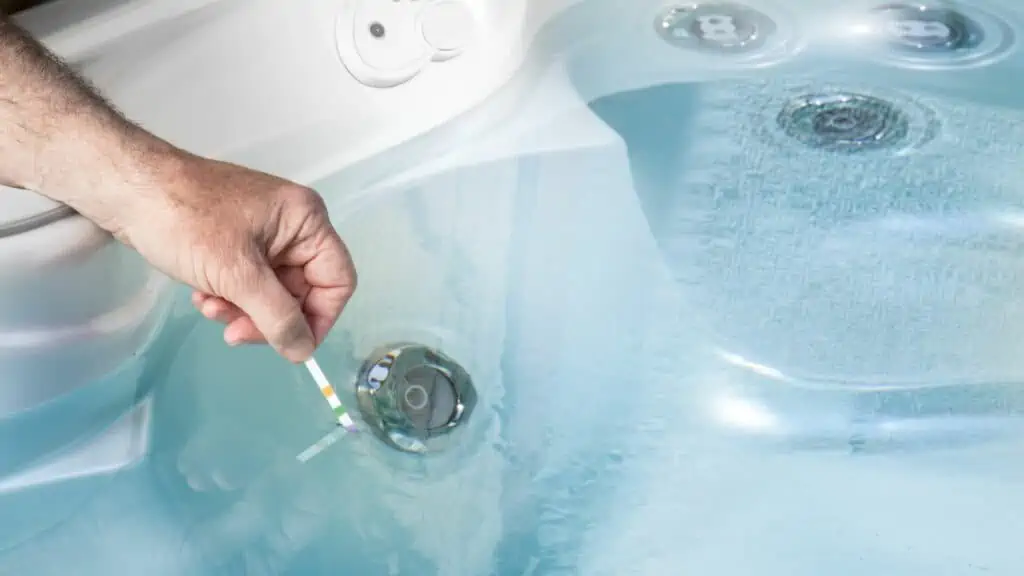Shocking your hot tub is important and should be a regular part of your maintenance routine.
The amount of water in a hot tub is relatively small (when compared to a swimming pool), so the levels of contaminants can increase very quickly if you use the hot tub frequently.
Shocking and keeping the pH and sanitizer levels correct are ways to deal with this.
Knowing how to shock is all very well, but how do you know how often or when to shock your hot tub?
Hopefully, this article will help you decide.

How often should you shock your hot tub?
The opinions on how often to shock hot tub water are divided. Some say hot tubs should be shocked every week, others say twice per week, while others recommend using hot tub shocks at least once every two weeks. One thing is clear: you should do it regularly.
It depends on how often you use the spa, how many times you use it, where it is situated, the water temperature, etc.
You should test the water in your hot tub often, particularly when you are new to owning one, as this will give a good indication of how often you should shock it. You should use good-quality water test strips, such as the Aquachek 7-way test strips. These work for both chlorine and bromine hot tubs.
Recommended Test Strips
Over time you will know what frequency works best for you depending on how often and how many people use it.
Our hot tub is mainly used by me, and I use it around three times per week on average, so I generally give it a shock treatment every 10-14 days. I test the water between treatments, though.
In the end, it is important to bathe in clean water that does not make you sick. When the hot tub is used often, spa shock once a week is highly recommended.
Did you have lots of guests over, so the spa has a high bather load? It would be advisable to shock it right after that occasion so that the next time you go to your hot tub, you won’t find the water dirty and cloudy.
At the end of the day, if in doubt, shock!
When to shock a hot tub?
If you are going to shock the hot tub to correct a problem with the water, such as cloudy water or even signs of algae, then you should shock the hot tub immediately. You do not want to waste a moment getting the water back into good condition, and delaying may make the situation worse.
If you are simply going to shock as part of your regular maintenance, then the best time to do it is after you use it. This will give it time for the shock to do its work and for the chemical levels to reduce to normal again, ready for your next soak.
If you have just refilled the hot tub after cleaning it, after it has been empty for a while, or if it is a new hot tub, then you should shock it as a matter of course.
Read my complete guide to How to Shock a Hot Tub

When can you go in again after shocking?
If you use a chlorine-based shock, you will need to wait longer to use the hot tub again than if you use a non-chlorine oxidizer shock.
Chlorine-based shock chemicals are not safe to bathe in at a high concentration. They can be very harsh on the skin and bad for your lungs. The time to wait depends on the chlorine levels when you test the water, but it can take 24 hours to reach a safe level.
You can use the tub again in as little as twenty minutes when using non-chlorine shock.
Always read the labels on the hot tub chemicals you buy. They will advise you how long it takes for the reaction to be complete and when it is safe to get back in.
Read: How long to wait after shocking a hot tub
Which type of shock should be used for hot tubs?
Unsurprisingly, chlorine is the most usual type of hot tub shock for use with a chlorine hot tub.
The two main types of chlorine shock are dichlor shock (dichloroisocyanuric acid) and cal hypo (calcium hypochlorite).
Most brands of spa shock contain dichlor, which I recommend. Cal hypo is more suitable for shocking swimming pools.
You can also use a non-chlorine shock, known as an oxidizer. This type of shock allows you to use the hot tub again much sooner than chlorine shock.
You can use chlorine-based or non-chlorine-based shocks in a bromine hot tub. I would use a non-chlorine oxidizer shock once a week.
I recommend using SpaGuard Spa Shock or SpaGuard Spa Shock-Oxidizer
Hot Tub Maintenance Course
I bought Swim University’s Hot Tub Maintenance Course a while after I bought my first hot tub and struggled to maintain it. It was very well spent and has paid for itself many times over the years as I have saved by not needing to use as many chemicals as I did previously.
Listen to our Hot Tub Course Review Podcast:
Why shock hot tubs?
Some people wonder why they should shock their hot tub when they use plenty of sanitizer weekly. Unfortunately, only using sanitizing products won’t eliminate some things in the water that a weekly shock will.
The chlorine you use regularly will be stabilized. This means it also includes CYA (cyanuric acid), which slows down the evaporation of chlorine from the hot tub’s water, allowing it more time to sanitize the water.
Chlorine shock is unstabilized, so it acts quicker and dissipates quickly.
Shocking a hot tub has many benefits:
- Shock treatment breaks down chloramines (or bromamines) and chlorine/bromine molecules attached to contaminants. These are what give a hot tub that “chlorine swimming pool smell.” Without shocking, these will continue to build up.
- Everyone who jumps in your hot tub takes some sort of organic contaminants with them. These contaminants include dead skin cells, hair, shampoo, sunscreen, perfumes, deodorants, oils, etc. Shock will help kill bacteria and keep the hot tub clean.
- Shocking a hot tub will keep the water fresh and clear. (If the water is unclear, the hot tub needs to be shocked.)

Should you shock before or after using the spa?
When people ask if they should shock before or after using the spa my answer is that both can be true.
Provided the spa water is in good condition, you are only intending to give the hot tub a shock as part of your weekly maintenance. If you are planning to get in soon, it is best to do it after spending some time in the water.
On the other hand, if you plan to bathe in a few hours, then shocking it before should not be a problem, but you should test it to check the chlorine level first.
That being said, you are advised to shock the spa after you have used it. This will give the chemical reaction all the time it needs to clean the water and get it down to normal levels. The normal levels will be much easier on your skin.
What happens if you dont shock your hot tub?
If you never shock your hot tub then chloramines (or bromamines if you use bromine as a sanitizer) will continue to build up in the hot tub water.
This will mean your sanitizer will be much less effective at killing bacteria and other contaminants.









Leave a Reply